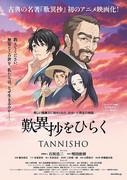A thorough explanation of the appeal and depth of "Opening the Tannisho"!

"Opening the Tannisho": A fusion of profound Buddhist thought and human drama■ Public Mediatheater ■ Original Medianovel ■ Release dateMay 24, 2019 - January 1, 0000 ■Distribution companyQ-Tech ■Frequencies98 min ■ Number of EpisodesEpisode 1 ■Original StoryTakamori Kenchu ■ DirectorKazutoshi Ohno ■ ProductionAnimation Production: East Fish Studio ■Works©2019 "Opening the Tannisho" Film Production Committee. ■ StoryKamakura period, early 1200s. Born into a poor farming family, intelligent and intelligent Heijiro meets Saint Shinran one day, where he learns and grows. When Saint Shinran returns to Kyoto, Heijiro leaves his hometown to follow him. He is given the name "Yuien" and studies Buddhism under Saint Shinran with his friends. When Yuien learns that his old friend is in a difficult situation, he is overcome by a sense of powerlessness and is tormented by his inability to do anything. Why are evil people saved more than good people? Why do people live? The true meaning of Saint Shinran's words, "All humans are evil, and there are no conditions for salvation," is revealed. ■ExplanationThe new animated film "Opening the Tannisho" is currently in production as the second in the "Why Live" series of animated films, which were shown for 29 consecutive weeks. Written in the late Kamakura period and etched in history, "Tannisho" has fascinated many intellectuals throughout history. What is it about "Tannisho" that continues to attract so many people? In the film "Opening the Tannisho," the true meaning of this book, which is said to have had a major impact on Japanese thought, is brilliantly unravelled in the story. ■Cast・Saint Shinran/Koji Ishizaka ・Yuien/Toshiki Masuda ・Soken/Yoshimasa Hosoya ■ Main staff・ Director: Kazutoshi Ohno ・ Original story: Kenchu Takamori "Opening the Lament" (10 ... ■ Main Characters・Saint Shinran: The founder of the Jodo Shinshu sect, a real person who lived during the Kamakura period. He met Heijiro (later Yuien) and others while he was actively engaged in missionary work and writing in Inada (present-day Ibaraki and Hitachi). Even after leaving Inada and returning to Kyoto, he continued to be the mentor and guide of Heijiro and his friends for the rest of his life. ■ Related works・Original work: Kenchu Takamori, "Opening the Tannisho" (published by Mannendo Publishing) The appeal and evaluation of "Opening the Tannisho""Tannisho wo Hiraku" is an animated film depicting Buddhist thought in the Kamakura period, and its profound themes and beautiful visuals have been a hot topic. Below, we will take a closer look at the appeal and reviews of this work. Depth of storyThe story of this work depicts the process in which a young man named Heijiro (Yuien) meets Saint Shinran and grows through the teachings of Buddhism. In particular, Saint Shinran's words, "All humans are evil, and there are no conditions for salvation," are at the center of the story, making viewers think deeply about why evil people are saved more than good people, and the meaning of human existence. This theme is easy to empathize with even in modern society, and has deeply moved many viewers. Character AppealEach character in this series is unique and leaves a strong impression on viewers. In particular, the voice acting of Ishizaka Koji, who plays Saint Shinran, captures the hearts of viewers with his realistic portrayal of a character who is both strict and compassionate. Masuda Toshiki's performance as Yuien also realistically portrays the growth and struggles of a young man, eliciting sympathy from viewers. Other characters such as Soken, Asa, and Gonpachi also have their own carefully drawn backgrounds and feelings, enriching the story as a whole. Visuals and MusicThe visuals of this work are highly visually appealing, beautifully recreating the scenery and costumes of the Kamakura period. In particular, the scenes depicting Saint Shinran's sermons and Yuen's suffering use color and light skillfully, evoking the emotions of the viewer. In addition, the music by Toru Hasebe is an important element in enhancing the atmosphere of the story, resonating deeply with the viewer. Credit to the director and staffDirector Kazutoshi Ohno's direction is full of ingenuity in order to visually express the profoundness of Buddhist thought. In particular, in the scenes where the words of Saint Shinran are visualized, he uses abstract expressions to encourage viewers to think deeply. In addition, with the cooperation of the staff, including screenwriter Kiyoto Wada, chief animation director Yasuharu Kitahara, and art director Norifumi Nakamura, the worldview of the story is depicted richly. Recognition and Awards"Opening the Lament" has been highly praised as the second installment of the "Why Live?" series, which was shown for 29 consecutive weeks. In particular, as an animated film themed on Buddhist thought, it has deeply touched and sympathized with viewers, and has won many awards. Specifically, it won the 2019 Japan Animation Film Award, with director Kazutoshi Ohno receiving the Best Director award. In addition, composer Toru Hasebe won the Best Music award, and the high quality of the entire work has been praised. Recommended points of "Opening the Tannisho""Opening the Tannisho" is an animated film with a Buddhist theme that can be recommended to many viewers. Below are some points that I would particularly like to recommend it for. Deep ThemesThe theme of this work makes viewers think deeply about why evil people are saved more than good people, and the meaning of human existence. These themes are easy to empathize with in modern society and will deeply move viewers. In particular, the words of Saint Shinran, "All human beings are evil, and there are no conditions for salvation," will resonate deeply with viewers. Beautiful visualsThe visuals of this work are highly visually appealing, beautifully recreating the scenery and costumes of the Kamakura period. In particular, the scenes depicting Saint Shinran's sermons and Yuen's suffering use color and light skillfully to enhance the viewer's emotions. These visuals will leave a deep impression on the viewer. Inspirational MusicThe music by Toru Hasebe is an important element in enhancing the atmosphere of the story, and resonates deeply with the viewers. In particular, the music in the scenes expressing the words of Saint Shinran has the effect of enhancing the emotions of the viewers. These pieces of music will leave a deep impression on the viewers. Character DevelopmentEach character in this work is unique and leaves a strong impression on the viewer. In particular, the scenes depicting Yuen's growth and suffering elicit sympathy from the viewer. Additionally, the backgrounds and feelings of characters such as Saint Shinran, Soken, Asa, and Gonpachi are carefully depicted, enriching the story as a whole. The growth of these characters will leave a deep impression on the viewer. Credit to the director and staffDirector Kazutoshi Ohno's direction is full of ingenuity in order to visually express the profoundness of Buddhist thought. In addition, the story's worldview is richly depicted thanks to the cooperation of the staff, including screenwriter Kiyoto Wada, chief animation director Yasuharu Kitahara, and art director Norifumi Nakamura. These achievements will leave a deep impression on viewers. Conclusion"Opening the Lament" is an animated film themed on Buddhist thought that can be recommended to many viewers. It is full of many attractions, including profound themes, beautiful visuals, moving music, character development, and the achievements of the director and staff. In particular, Saint Shinran's words, "All human beings are evil, and there are no conditions for salvation," will resonate deeply with viewers. Viewers will be deeply moved and sympathetic to this film. |
<<: A thorough analysis of the shocking visual beauty and profound themes of "Violence Voyager"!
>>: Promare Review: An animated masterpiece that depicts the power of fire
Recommend
After the end of "The Battle of Two Cities", Riot will also launch three dramas exploring the world view of "League of Legends"
The second season of the highly anticipated Leagu...
Uta no Prince-sama♪ Maji LOVE 2000% - The appeal and reviews of the episodes not aired on TV
The appeal and evaluation of "Uta no Prince-...
New stills from the first episode of Mamoru Oshii's new animation "Fire Hunter" will be aired on January 14
The new original animation "Fire Hunter"...
New trailer for the Slam Dunk movie introduces Mitsui Hisashi
The new animation trailer of the "Slam Dunk&...
Hisaishi's "My Neighbor Totoro" stage play won five London drama awards
"My Neighbor Totoro" was proposed and p...
Fujiwara Tatsuya's new film "The Dove's Fighting Method" will be released on August 27
The movie "The Dove's Fighting Method&qu...
The second season of the TV animation "To My Eternal Love" will be aired in the fall of 2022
The second season of "To My Immortal Love&qu...
The appeal and reviews of "Hungry Heart WILD STRIKER": A passionate story of soccer and youth
Hungry Heart WILD STRIKER - The charm and emotion...
Netflix's "Ultraman" Season 2 Character Promotional Video Justice Youth Higashi Kotaro
The second season of Netflix's 3DCG animation...
Weathering With You received positive reviews that exceeded expectations and was shortlisted for the Toronto International Film Festival Grand Prix
The new animated film Weathering with You, by Mak...
Japan's largest doujinshi sale C99 will not be held in December
Due to the impact of the new crown epidemic, Japa...
No surprise, the first place! The most sexy male character in Jump over the past 50 years
On May 25th, the Japanese ranking professional we...
The director personally responded to the rumors of the sequel to "Joker": There is no work at all at the moment
Previously, Deadline and The Hollywood Reporter h...
The new film directed by "Kick-Ass" has been quietly filmed, and Thor has joined
Director Matthew Vaughn's new film "Argy...
The latest CM for the second season of "The Quintessential Quintuplets" is released and will be aired in January 2021
The second season of the famous romantic comedy &...









